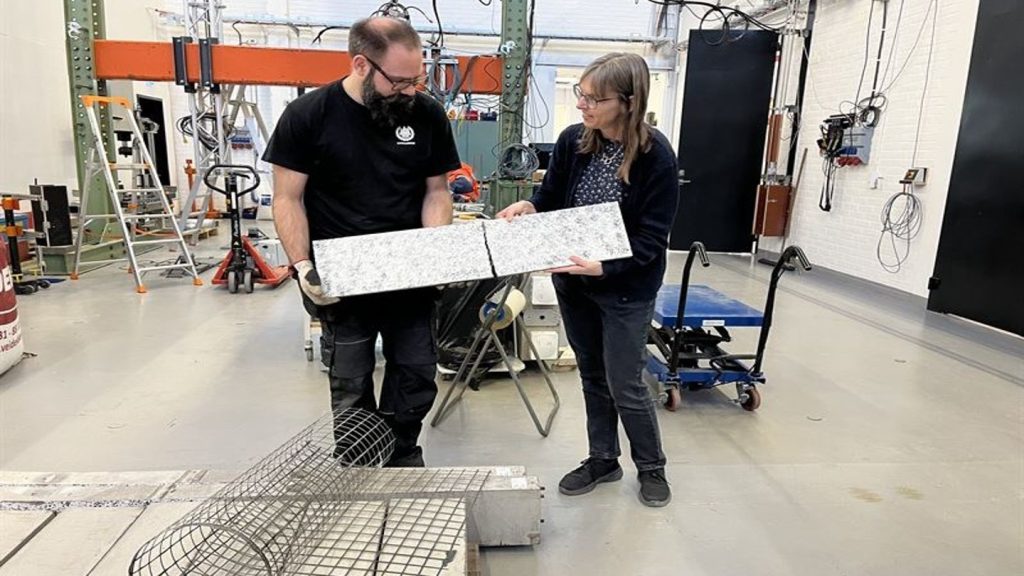S_Pavilion
Lately, Rhino, the 3D modelling software from Robert McNeel & Associates, has given rise to a veritable Noah’s Ark of related software. In recent years, architect-developers have been creating a profusion of plug-ins for Rhino’s Grasshopper (a graphical algorithm editor) to expand the community’s design capabilities. One free Grasshopper plug-in that’s been attracting attention is Kangaroo, a live physics engine developed by tech-savvy architect Daniel Piker.
Kangaroo is still in beta, but has already been used in projects including the S_Pavilion – a sustainable structure made of recycled swimsuits and FSC-certified timber – designed by senior lecturer Cyril Shing, co-teacher Yiching Liu and their BA interior and spatial design students from the Chelsea College of Art and Design.
Though exploring the power of digital design to help create innovative forms, Shing wanted to make sure the students remained grounded in the practical realities of materials and their physical properties. “In the parametric world, you can generate gorgeous, amazing structures easily,” he observes, but when structural engineering concerns are overlooked, those enticing forms are often unbuildable. Kangaroo digitally simulates the behaviour of materials, keeping the students’ design work rooted in the rules of real-world physics.
The class began in 2009 by designing avant-garde fashions – a fun exercise in creating spatial envelopes. This taught the students how to use Grasshopper to examine the geometries of a fabric’s surfaces. In early 2010, they moved on to a more ambitious project, the design of the pavilion, created with the help of a donation of hundreds of Speedo swimsuits.
Using Kangaroo, the students were able to input various parameters, such as the fabric’s stretchiness, to simulate how the material would behave when assembled into an architectural structure. They were also able to experiment with the fabric’s capacity to help support the form of the pavilion.
See Also:
A number of the students’ best designs were combined to create the final design, currently located at the Cass Sculpture Foundation in West Sussex.
How well do you really know your competitors?
Access the most comprehensive Company Profiles on the market, powered by GlobalData. Save hours of research. Gain competitive edge.

Thank you!
Your download email will arrive shortly
Not ready to buy yet? Download a free sample
We are confident about the unique quality of our Company Profiles. However, we want you to make the most beneficial decision for your business, so we offer a free sample that you can download by submitting the below form
By GlobalDataThe 3m-high pavilion features tree-like fabric forms supported by a grid-shaped timber frame. While the grid provides structural support, so too does the tension of the fabric – like a big rubber band, it helps to hold the grid in place.
Since the fabric plays a structural role, the grid’s connecting joints could be kept to a minimum, which lowered costs and simplified the fabrication process.
One strength of Kangaroo is its ease of use; it’s not too difficult for non-professionals, such as Shing’s protégés, to pick up. While the software is still a work in progress, since it’s in beta, Shing praises its potential to serve as a bridge between the digital and the physical.
Mall of Scandinavia
When many members of a design team all need to work on the same 3D model, coordinating the workflow can be tricky. Over the past couple of years, various software companies have brought out online collaboration tools to help deal with the problem, including Graphisoft, which offers the BIM Server. A free standalone application that comes with ArchiCAD, the BIM Server is designed to facilitate real-time online collaboration among team members working on large BIM projects. “The BIM model resides on a central server, to which any number of architectural clients can be connected,” explains Akos Pfemeter, Graphisoft’s director of global marketing.
Swedish architecture firm BAU used the BIM Server to ensure smooth, fluid working during the planning of a large, complex project – the 120,000m² Mall of Scandinavia in Stockholm. BAU created the master plan for the mall and its surroundings, and later designed the mall itself in collaboration with Benoy, explains Stig Bengtsson, a BIM manager at BAU and a Graphisoft consultant.
BAU began using the BIM Server in the mall-design project in 2009, around the time the product first became available with ArchiCAD 13. The firm had previously used an old version of Graphisoft’s Teamwork, which was more cumbersome because users had to completely sign out of a project to release their portion of a model when someone else needed it, says Bengtsson. “If [there] were more than three people in a project, there were always conflicts,” he recalls.
“With the BIM Server, you don’t have those conflicts, because it’s so quick and easy to switch work areas, and if somebody needs something that you have, you just instantly release it,” he says. If one person needs to ask someone else to release a portion of the model, he can use a built-in instant messaging system. As a side benefit to the BIM Server’s smoother workflow, the 15-member team was able to reduce the number of mall models it was using from around five to three, since more people could work simultaneously in each one.
BAU is now using the BIM Server in around 19 other projects, but the technology provided the most dramatic efficiency boost in the Mall of Scandinavia project, because of the design’s large scale. “The larger the project is, the more advantages you have with the BIM Server,” Bengtsson says.
Gladstone Public Library
Autodesk’s Revit conceptual energy analysis (CEA) is a new tool to help architects and engineers make choices early in the design process in order to boost a building’s sustainability. After creating a simple conceptual model and specifying some basic design elements, CEA can be used to analyse what a building’s energy performance would be. By running analysis reports on multiple design concepts, users can easily compare them in terms of their ecological impact.
CEA was put through its paces by sustainable engineering firm Glumac, when Portland, Oregon-based THA Architecture asked the engineers to do an energy analysis at the conceptual design phase for a new green library building in nearby Gladstone. The 18,000ft² design is targeting an LEED Gold or Platinum rating.
Skander Spies, Glumac’s primary energy analyst on the project, took a few hand-drawn sketches of various different conceptual designs from THA and copied them in Revit, creating 3D models. Then for the various models, the Glumac team ran CEA reports several times, adjusting certain variables each time to see how the energy usage changed. The engineers focused on four variables: wall-and-roof insulation, total window area, window thermal performance and HVAC system type. For each of those variables, they tried out both a low value (the code minimum) and a high value in CEA, to figure out what kind of design changes would make the most impact.
“The architect was particularly interested in the break point at which we have to have triple-glazed windows to earn more LEED points,” Spies says. By using CEA, the engineers were able to determine that they couldn’t earn more than 16 LEED points without going to triple-glazed windows. They also noticed that choosing a smaller total window area with double glazing resulted in worse energy performance than choosing a much larger percentage of window area with triple glazing. Therefore, the engineers advised THA that the higher cost of triple-glazed windows might well be worth the boost in energy performance and LEED points.
Though CEA was helpful in many aspects of the project, Spies offered some criticisms. He wished there were more options for different kinds of HVAC systems, more sophisticated options for occupancy patterns, and the ability to specify the lighting power usage, he says. Overall, though, he was enthusiastic about CEA’s ease of use and accessibility to a wide range of users. When calculating anticipated energy use, all too often “it’s easy to come up with an ‘estimate’, but that doesn’t mean anything, because it wasn’t developed using sound principles. CEA is a tool that makes sound principles and practices very accessible to a lot of people,” Spies says. “These kind of tools are allowing us to give feedback [on energy efficiency] faster and earlier in the design process, which is great, and it’s really a key piece in creating more sustainable buildings.”





